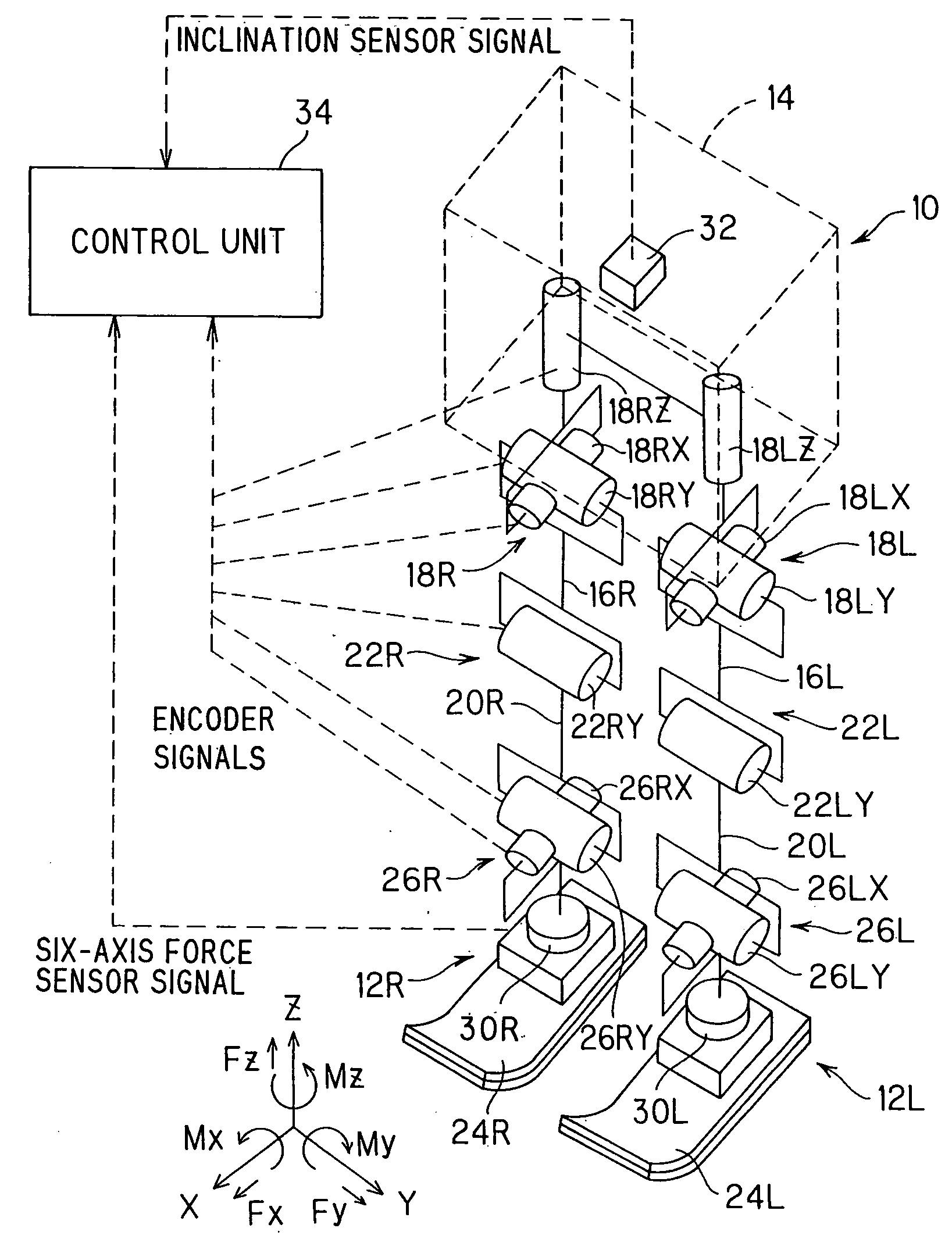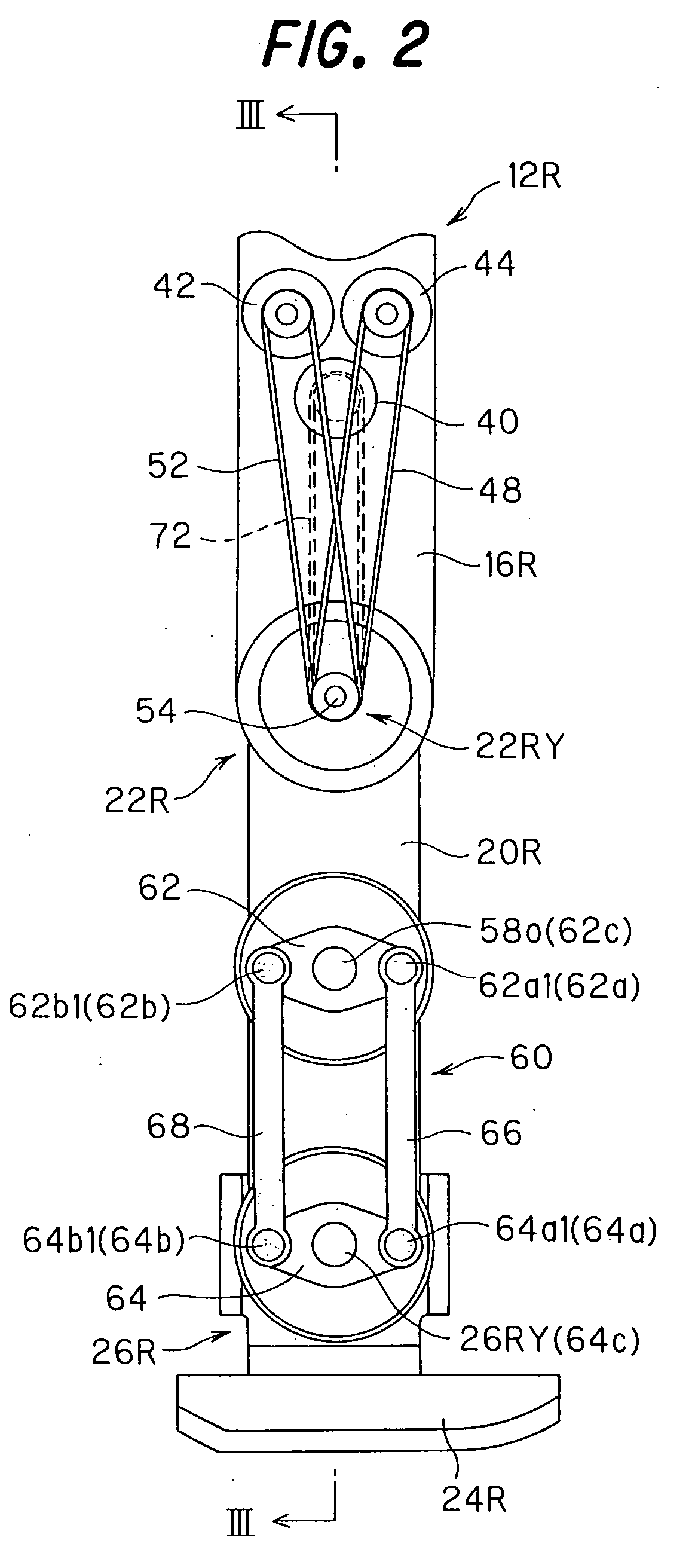Leg type movable robot
a robot and leg technology, applied in the field of legged mobile robots, can solve problems such as adverse effects on the external appearance of legs
- Summary
- Abstract
- Description
- Claims
- Application Information
AI Technical Summary
Benefits of technology
Problems solved by technology
Method used
Image
Examples
second embodiment
[0073] Next, the legged mobile robot according to the present invention will be described.
[0074]FIG. 5 is a right-hand side view showing the distal end from the shank link of the leg in the legged mobile robot according to the second embodiment, and FIG. 6 is a right-hand side view similar to FIG. 4, showing the distal end from the shank link when the ankle Y-axis has been rotated −60 degrees.
first embodiment
[0075] As described in the first embodiment, setting both the angle formed by the one end 62a, the midpoint 62c, and the other end 62b of the first crank, and the angle formed by the one end 64a, the midpoint 64c, and the other end 64b of the second crank to about 180 degrees has the advantage that no additional stress is applied to the bearing 84 for supporting the ankle Y-axis 26RY (26LY) because the transmissive force of the first crank and the transmissive force of the second crank balance each other out (constitute a couple of forces).
[0076] However, such a configuration has been inconvenient in that rotation becomes difficult (specifically, a dead point is present) when the one end 62a, the midpoint 62c, and the other end 62b of the first crank, and the one end 64a, the midpoint 64c, and the other end 64b of the second crank are all positioned along the same straight line.
[0077] In view of this, in the second embodiment, the angle formed by the one end 62a, the midpoint 62c, ...
third embodiment
[0081] Next, a legged mobile robot according to the present invention will be described.
[0082] In a legged mobile robot, the torque exerted on the ankle joint is generally determined by the gait pattern. In view of this, the third embodiment is configured such that the angle formed by the one end 62a, the midpoint 62c, and the other end 62b of the first crank, and the angle formed by the one end 64a, the midpoint 64c, and the other end 64b of the second crank vary in response to the gait pattern of the mobile robot 10, or, specifically, the angles are set based on the torque about the ankle Y-axes 26RY and 26LY determined from the gait pattern.
[0083]FIG. 7 is a right-hand side view similar to FIG. 5, showing the distal end from the shank link in the leg of a legged mobile robot according to the third embodiment. FIG. 8 is a right-hand side view showing the distal end from the shank link when the ankle Y-axis has been rotated a degrees.
[0084] Before the descriptions of FIGS. 7 and ...
PUM
 Login to View More
Login to View More Abstract
Description
Claims
Application Information
 Login to View More
Login to View More - R&D
- Intellectual Property
- Life Sciences
- Materials
- Tech Scout
- Unparalleled Data Quality
- Higher Quality Content
- 60% Fewer Hallucinations
Browse by: Latest US Patents, China's latest patents, Technical Efficacy Thesaurus, Application Domain, Technology Topic, Popular Technical Reports.
© 2025 PatSnap. All rights reserved.Legal|Privacy policy|Modern Slavery Act Transparency Statement|Sitemap|About US| Contact US: help@patsnap.com



